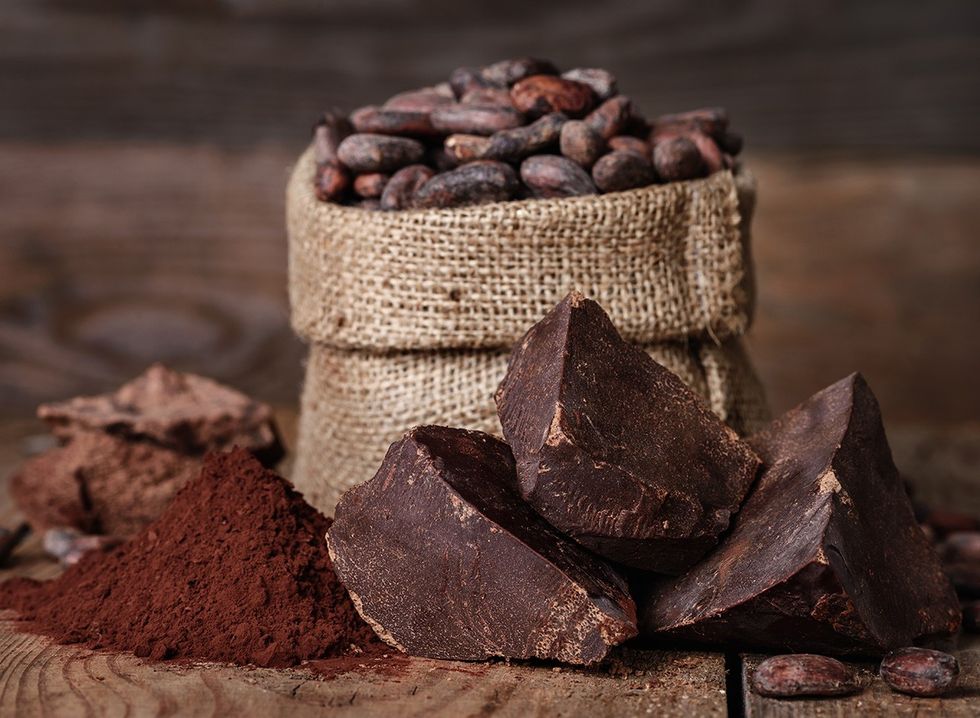Diet is crucial to healthy aging. “Healthy eating habits are important at every age, but they can make a big difference as we get older and our nutritional needs change,” says Karen Voci, president of the Harvard Pilgrim Health Care Foundation. “Preparing delicious meals using fresh, local produce is fun and healthy at every stage of life, and can help us feel better and improve our health and wellbeing.” Here are 9 foods that fight aging, make you feel good, and help you look amazing.
Tomatoes

The humble tomato packs a mighty anti-aging punch, experts say. “Tomatoes have vitamin C, which helps build collagen and improve the appearance of wrinkles by making your skin look firmer,” clinical dietitian Haley Robinson tells Piedmont Healthcare. “They also contain lycopene, which helps protect your skin from UV damage.”
Olive Oil

Olive oil is full of healthy fats which are good for you inside and out. “Favorite anti-aging ingredient of the Mediterranean diet which has proved to be so beneficial in improving blood vessel function, and maintaining a healthy heart,” says the American Cancer Fund. “It is rich in monounsaturated fats which help lower cholesterol levels. Recently it has been found that extra virgin olive oil contains an anti-inflammatory compound, which may help people with arthritis.”
Dark Chocolate

Dark Chocolate is the perfect anti-aging treat. “It is not just a treat but a dose of cocoa flavanol, a powerful moisture-retaining and skin-buffing anti-oxidant,” says Genesis Healthcare System. “Rough skin is another sign of aging. Exposure to free radicals in the air and manipulation from daily washing can dry the skin and roughen it. The antioxidant in dark chocolate protects the skin by increasing blood flow and securing moisture. Indulge sparingly as it may contain refined sugar.”
RELATED: Lose Abdominal Fat in 150 Days with the Blue Zones Diet
Berries

Berries are good for your skin, cells, and brain. “Berries can fight off free radical cells and help regenerate new skin,” Robinson says. “And the compounds in berries help reduce inflammation and oxidative damage, which are two things that have been associated with age-related memory deficit and motor function.”
Avocado

Avocados are delicious, versatile, and nutritious. “Another superfood considered to be high in fat, but again, we are talking about the beneficial monounsaturated fat,” says the American Cancer Fund. “Nutritionally, avocados are almost a complete meal in themselves, containing high levels of many vitamins, especially vitamins E and C.”
Eggs

Eggs are full of protein and healthy fats. “As we age, our skin wrinkles from weakening of collagen and elastin in our skin,” Robinson says. “Amino acids help rebuild and repair damaged skin. A diet high in protein-rich foods such as meat, fish, eggs, and nuts may help prevent wrinkling.”
RELATED: Top 8 Superfood Smoothies You Should Eat Every Day to Lose Weight
Brazil Nuts

“Brazil nuts are considered high in fat, but this is unsaturated fat, considered to be the ‘good’ fat,” says the American Cancer Fund. “They are an excellent source of the antioxidant selenium, which neutralizes free radicals in the body. Just two or three brazil nuts a day will provide you with adequate levels of selenium.”
Greek Yogurt

“This two-in-one anti-aging food reduces skin inflammations such as acne and eczema, and it contains proteins that maintain your collagen. Your gut carries good bacteria called a microbiome. Microbiomes host your immune system and regulate your body's inflammatory response. Greek yogurt promotes healthy skin and brightens and tones its overall appearance.”
RELATED: 20 Superfoods for People Over 50
Oily Fish

“Oily fish, such as salmon, mackerel, tuna, and sardines, are top sources of Omega-3 fatty acids,” says the American Cancer Fund. “These are absolutely the ‘in’ nutrients of the moment, said to help lower the risk of blood clots and the build-up of fatty deposits on arteries.” And if you enjoyed this article, don't miss 20 Incredible Ozempic Success Stories of All Time.














 Shutterstock
Shutterstock Shutterstock
Shutterstock Shutterstock
Shutterstock VegetablesShutterstock
VegetablesShutterstock Shutterstock
Shutterstock Shutterstock
Shutterstock Shutterstock
Shutterstock NutsShutterstock
NutsShutterstock Shutterstock
Shutterstock Shutterstock
Shutterstock Sweet PotatoesShutterstock
Sweet PotatoesShutterstock Shutterstock
Shutterstock Shutterstock
Shutterstock
 Shutterstock
Shutterstock Shutterstock
Shutterstock Shutterstock
Shutterstock Shutterstock
Shutterstock Shutterstock
Shutterstock Shutterstock
Shutterstock
 31. Strawberries: 32 caloriesShutterstock
31. Strawberries: 32 caloriesShutterstock Shutterstock
Shutterstock Shutterstock
Shutterstock Shutterstock
Shutterstock Prebiotic Foods: FlaxseedsShutterstock
Prebiotic Foods: FlaxseedsShutterstock 1. Extra Virgin Olive OilShutterstock
1. Extra Virgin Olive OilShutterstock Shutterstock
Shutterstock Shutterstock
Shutterstock Shutterstock
Shutterstock Shutterstock
Shutterstock 14. Mushrooms: 22 caloriesShutterstock
14. Mushrooms: 22 caloriesShutterstock

 Shutterstock/Prostock-studio
Shutterstock/Prostock-studio Shutterstock
Shutterstock Shutterstock
Shutterstock Shutterstock
Shutterstock Shutterstock
Shutterstock Shutterstock
Shutterstock Shutterstock
Shutterstock Shutterstock
Shutterstock Shutterstock
Shutterstock Shutterstock
Shutterstock

 I'm a Nutritionist and These 9 High-Protein Snacks Keep My Clients Full While Losing 50 Pounds
I'm a Nutritionist and These 9 High-Protein Snacks Keep My Clients Full While Losing 50 Pounds
 Shutterstock
Shutterstock 2. Processed FoodsShutterstock
2. Processed FoodsShutterstock Shutterstock
Shutterstock Shutterstock/Prostock-studio
Shutterstock/Prostock-studio Shutterstock
Shutterstock Pro TipsShutterstock
Pro TipsShutterstock Shutterstock
Shutterstock Shutterstock
Shutterstock Shutterstock
Shutterstock Shutterstock
Shutterstock Don’t Drink as Much AlcoholShutterstock
Don’t Drink as Much AlcoholShutterstock Most Women on GLP-1s Are Making a Few Common MistakesShutterstock
Most Women on GLP-1s Are Making a Few Common MistakesShutterstock Soda and Sugary DrinksShutterstock
Soda and Sugary DrinksShutterstock Shutterstock
Shutterstock Eat BreakfastShutterstock
Eat BreakfastShutterstock And Improve Insulin SensitivityShutterstock
And Improve Insulin SensitivityShutterstock Belly Flab Strip Tip: Sugar and Fat Calories Leave Its Mark on Your BodyShutterstock
Belly Flab Strip Tip: Sugar and Fat Calories Leave Its Mark on Your BodyShutterstock Shutterstock
Shutterstock The Drugs Mimic the GLP-1 Hormone Naturally Produced by the BodyShutterstock
The Drugs Mimic the GLP-1 Hormone Naturally Produced by the BodyShutterstock 3. Deep-Fried ItemsShutterstock
3. Deep-Fried ItemsShutterstock